
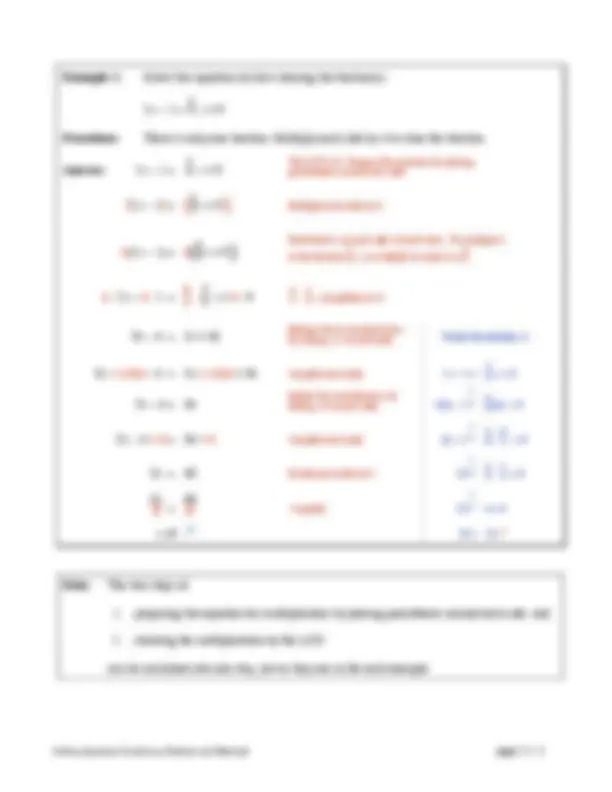
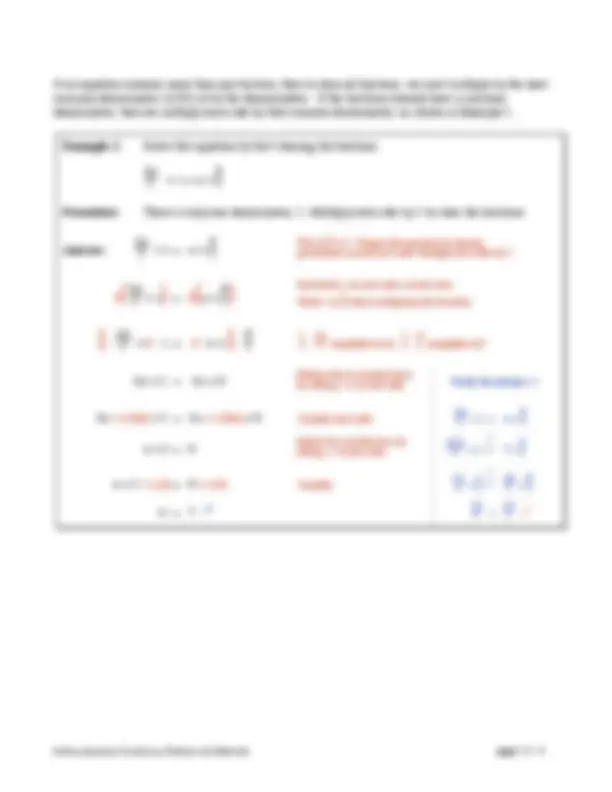
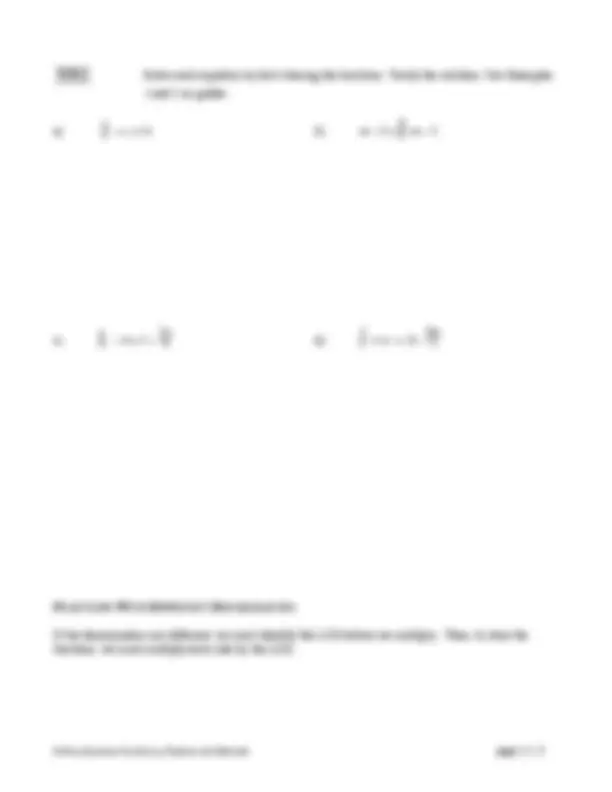
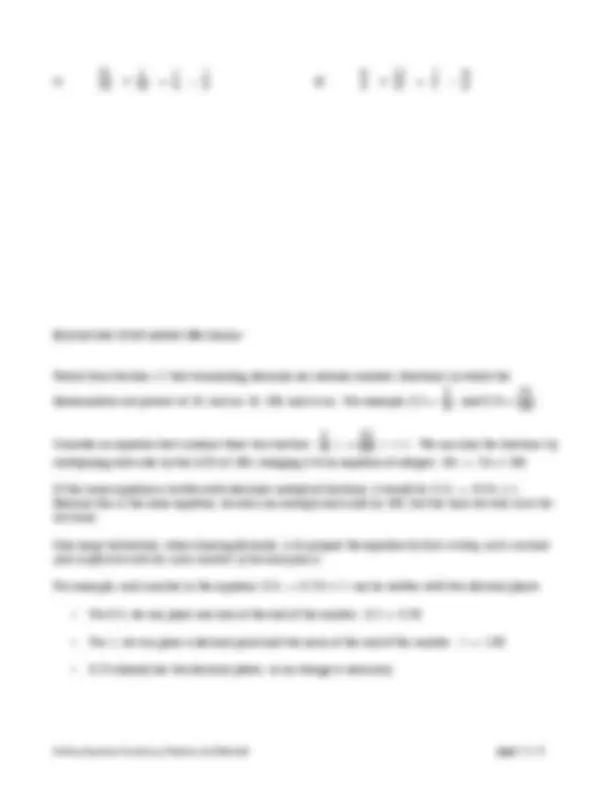
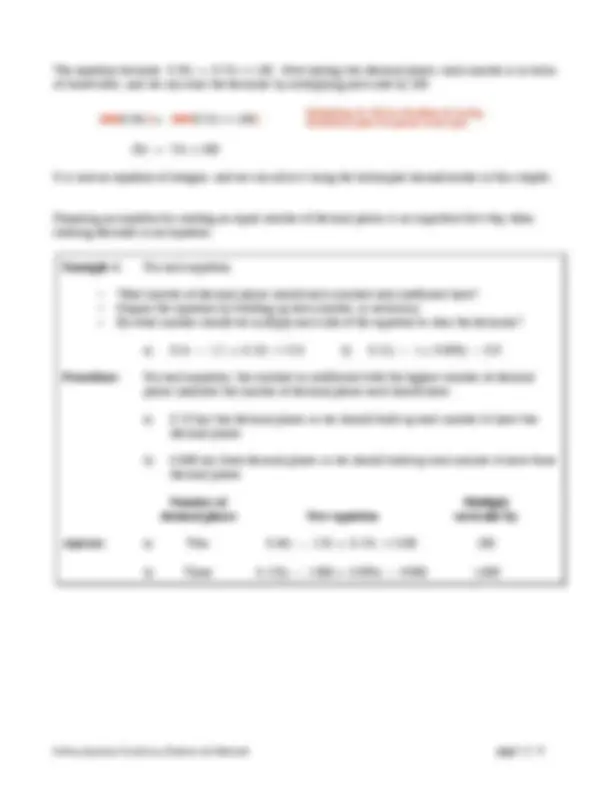
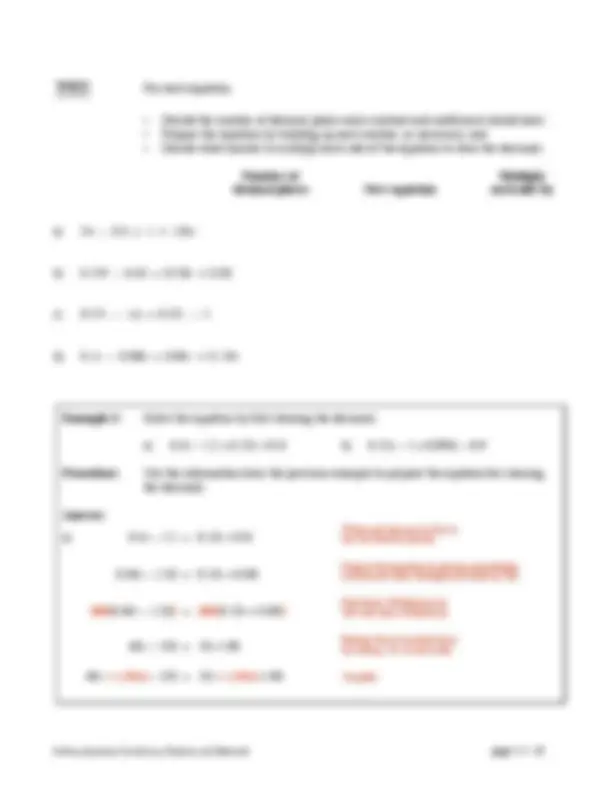
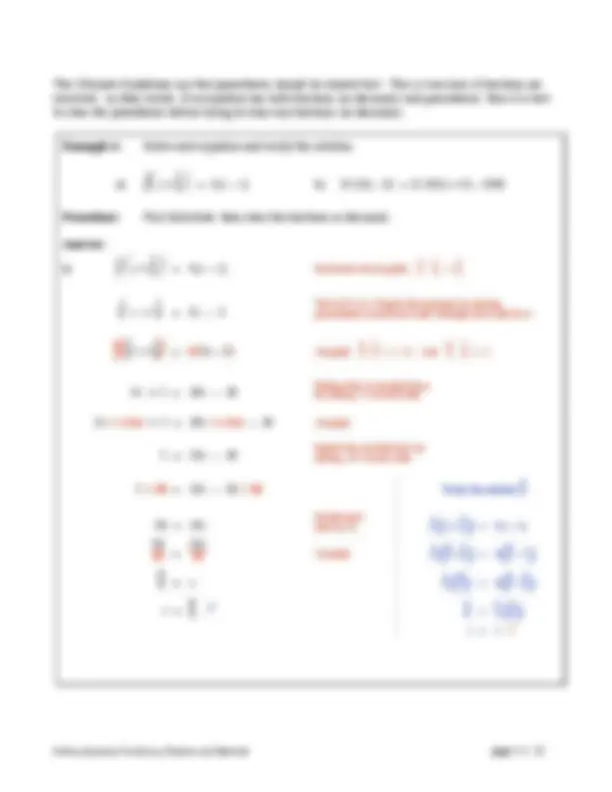
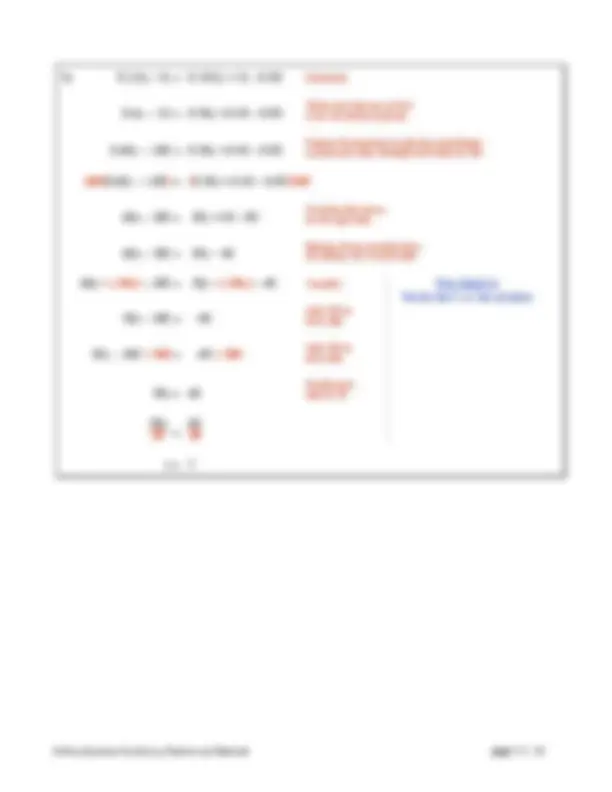
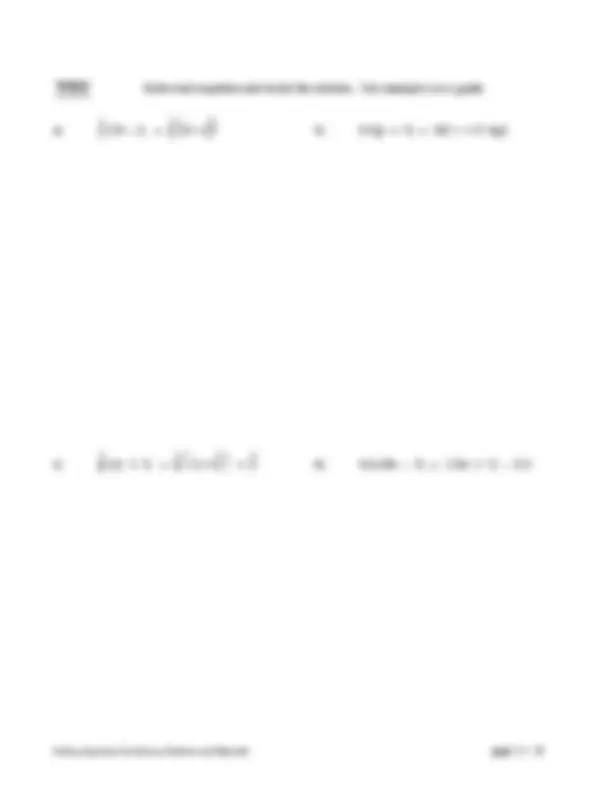
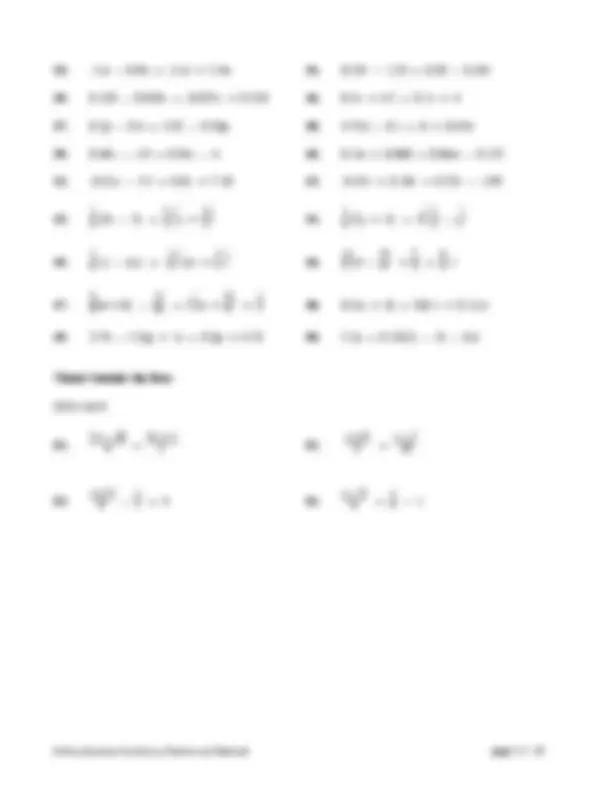


Study with the several resources on Docsity

Earn points by helping other students or get them with a premium plan


Prepare for your exams
Study with the several resources on Docsity

Earn points to download
Earn points by helping other students or get them with a premium plan
Community
Ask the community for help and clear up your study doubts
Discover the best universities in your country according to Docsity users
Free resources
Download our free guides on studying techniques, anxiety management strategies, and thesis advice from Docsity tutors
In this section, you will learn to: you need to understand: • Solve equations containing fractions. • Operations with real numbers (Chapter 1). • Solve ...
Typology: Study Guides, Projects, Research
1 / 18

This page cannot be seen from the preview
Don't miss anything!











Objectives To successfully complete this section,
In this section, you will learn to: you need to understand:
In Section 2.1 we solved equations that contained fractions. For example,
To solve w –
, we add
to each side: To solve 15 =
y , we multiply each side by
w –
y
w –
y
w + 0 =
= 1 y
w = 2 - 24 = y
y = - 24
In some equations, though, it is easier—and more efficient—to clear any and all fractions, thereby
making all of the constants and coefficients into integers.
For example, the equation
x
x – 1 is easier to solve after its fractions are cleared and it
has only integer constants and coefficients: 2 x + 24 = 9 x – 18.
What is it that allows us to transform
x
x – 1 into 2 x + 24 = 9 x – 18? It is
The Multiplication Property of Equality
We may multiply any non-zero number, c , to each side of an equation.
If a = b ,
then c · a = c · b, c ≠ 0
Applying the Multiplication Property of Equality to an equation such as
x
1
2
x – 1 requires
that we first prepare the equation by grouping each side as one quantity, using parentheses:
x
1
2
x – 1
It is then that we can apply the Multiplication Property of Equality and multiply each side by 18:
x
1
2
x – 1
The solving of this equation will be completed later in this section. To learn the process, let’s start with
some simpler equations.
Let us start with an equation that contains just one fraction, 2 x – 1 =
3
4
x + 9. It is possible to solve this
equation by first adding -
3
4
x to each side, but to avoid the time-consuming work involved with
fractions, it is often helpful to first clear the fraction —or clear the denominator —and work only with
integers.
Caution: “Clearing the fractions” requires us to multiply each full side of the
equation—each and every term— by the same value, the common
denominator. We do not multiply only the terms containing fractions.
~Instructor Insight
To this point, students have never been asked to create their own parentheses, so this extra step of preparation is
introduced. After Example 1, it will become part of the multiplication step.
As stated above, and as shown in Example 1, we must prepare the
equation for multiplication by grouping each side using parentheses:
3
4
x + 9
If an equation contains more than one fraction, then to clear all fractions, we must multiply by the least
common denominator (LCD) of all the denominators. If the fractions already have a common
denominator, then we multiply each side by that common denominator, as shown in Example 2.
Example 2: Solve this equation by first clearing the fractions.
3 w
Procedure: There is only one denominator, 2. Multiply each side by 2 to clear the fractions.
Answer:
3 w
The LCD is 2. Prepare the equation by placing
parentheses around each side. Multiply each side by 2.
3 w
w +
Distribute 2, on each side, to each term.
Write 2 as
2
1
when multiplying the fractions
3 w
2
1
·
3 w
2
simplifies to 3 w ;
2
1
·
9
2
simplifies to 9.
3 w + 2 = 2 w + 9
Reduce this to standard form
by adding - 2 w to each side.
Verify the solution, 7:
3 w + (- 2 w ) + 2 = 2 w + (- 2 w ) + 9 Simplify each side.
3 w
2
9
2
w + 2 = 9
Isolate the variable term by
adding - 2 to each side.
3 ( 7 )
2
?
=
7 +
9
2
w + 2 + (-2) = 9 + (-2) Simplify.
21
2
2
2
?
=
14
2
9
2
w = 7
23
2
=
23
2
YTI 1 Solve each equation by first clearing the fractions. Verify the solution. Use Examples
1 and 2 as guides.
a)
x
= x + 4 b) m – 3 =
m – 2
c)
x
2 x
d)
3 w
If the denominators are different, we must identify the LCD before we multiply. Then, to clear the
fractions, we must multiply each side by the LCD.
b)
y
y
The LCD is 12. Prepare the equation by placing
parentheses around each side. Multiply each side by 12.
y
y
Distribute 12, or
12
1
, on each side, to each term.
y
y
Simplify.
3 y + 1 = 4 y – 2
Reduce this to standard form
by adding - 3 y to each side.
3 y + (- 3 y ) + 1 = 4 y + (- 3 y ) – 2 Verify the solution, 3:
1 = y – 2
Isolate the variable term by
adding +2 to each side.
y
4
1
12
?
=
y
3
1
6
1 + 2 = y – 2 + 2 Simplify.
3
4
1
12
?
=
3
3
1
6
3 = y
9
12
1
12
?
=
6
6
1
6
y = 3
10
12
?
=
5
6
5
6
=
5
6
YTI 2 Solve each equation by first identifying the LCD and clearing the fractions. Verify
the solution. Use Example 3 as a guide.
a)
3 y
y
p
p
c)
3 x
x
d)
w
w
Recall from Section 1.2 that terminating decimals are rational numbers (fractions) in which the
denominators are powers of 10, such as 10, 100, and so on. For example, 0.3 =
and 0.25 =
Consider an equation that contains these two fraction:
x =
x + 1. We can clear the fractions by
multiplying each side by the LCD of 100, changing it to an equation of integers: 30 x = 25 x + 100.
If this same equation is written with decimals instead of fractions, it would be 0.3 x = 0.25 x + 1.
Because this is the same equation, we also can multiply each side by 100, but this time we will clear the
decimals.
One major distinction, when clearing decimals, is to prepare the equation by first writing each constant
and coefficient with the same number of decimal places.
For example, each number in the equation 0.3 x = 0.25 x + 1 can be written with two decimal places:
YTI 3 For each equation,
Number of Multiply
decimal places New equation each side by
a) 2 w – 0.4 = 1 + 1.8 w
b) 0.17 k – 0.43 = 0.25 k + 0.
c) 0.27 v – 1.6 = 0.32 v – 2
d) 0.1 x – 0.006 = 0.08 x + 0.
Example 5: Solve the equation by first clearing the decimals.
a) 0.4 x – 1.2 = 0.15 x + 0.8 b) 0.12 y – 1 = 0.095 y – 0.
Procedure: Use the information from the pervious example to prepare the equation for clearing
the decimals.
Answer:
a) 0.4 x – 1.2 = 0.15 x + 0.
Write each decimal so that it
has two decimal places.
0.40 x – 1.20 = 0.15 x + 0.
Prepare the equation by placing parentheses
around each side. Multiply each side by 100.
Distribute. Multiplying by
100 will clear all decimals.
40 x – 120 = 15 x + 80
Reduce this to standard form
by adding - 15 x to each side.
40 x + (- 15 x ) – 120 = 15 x + (- 15 x ) + 80 Simplify.
25 x – 120 = 80
Isolate the variable term
by adding 120 to each side.
25 x – 120 + 120 = 80 + 120 Simplify. Verify the solution, 8:
25 x = 200
Divide each
side by 25.
0.4(8) – 1.
?
=
0.15(8) + 0.
25 x
200 ÷ 25 = 8 3.2 – 1.
?
=
1.20 + 0.
x = 8 2.0 = 2.0
b) 0.12 y – 1 = 0.095 y – 0.
Write each decimal so that it
has three decimal places.
0.120 y – 1.000 = 0.095 y – 0.
Prepare the equation by placing parentheses
around each side. Multiply each side by 1 , 000.
Distribute. Multiplying by
1 ,000 will clear all decimals.
120 y – 1,000 = 95 y – 900
Reduce this to standard form
by adding - 95 y to each side.
120 y + (- 95 y ) – 1,000 = 95 y + (- 95 y ) – 900 Simplify.
25 y – 1,000 = - 900
Isolate the variable term
by adding 1 ,000 to each side.
25 y – 1,000 + 1,000 = - 900 + 1,000 Simplify. You finish it:
Verify that 4 is the solution.
25 y = 100
Divide each
side by 25.
25 y
100 ÷ 25 = 4
x = 4
The Ultimate Guidelines say that parentheses should be cleared first. This is true even if fractions are
involved; in other words, if an equation has both fractions (or decimals) and parentheses, then it is best
to clear the parentheses before trying to clear any fractions (or decimals).
Example 6: Solve each equation and verify the solution.
a)
x +
= 3( x – 1) b) 0.2(3 y – 5) = 0.15(2 y + 3) – 0.
Procedure: First distribute, then clear the fractions or decimals.
Answer:
a)
x +
= 3( x – 1) Distribute and simplify;
1
2
·
2
3
=
1
3
x +
= 3 x – 3
The LCD is 6. Prepare the equation by placing
parentheses around each side. Multiply each side by 6.
x +
6
1
·
1
2
x = 3 x and
6
1
·
1
3
= 2.
3 x + 2 = 18 x – 18
Reduce this to standard form
by adding - 3 x to each side.
3 x + (- 3 x ) + 2 = 18 x + (- 3 x ) – 18 Simplify.
2 = 15 x – 18
Isolate the variable term by
adding +18 to each side.
2 + 18 = 15 x – 18 + 18 Verify the solution
4
3
:
20 = 15 x
Divide each
side by 15.
1
2
x +
2
3
= 3( x – 1)
15 x
Simplify.
1
2
4
3
2
3
= 3
4
3
= x
1
2
6
3
= 3
4
3
3
3
x =
6
6
=
3
1
1
3
b) 0.2(3 y – 5) = 0.15(2 y + 3) – 0.85 Distribute.
0.6 y – 1.0 = 0.30 y + 0.45 – 0.
Write each decimal so that
it has two decimal places.
0.60 y – 1.00 = 0.30 y + 0.45 – 0.8 5
Prepare the equation by placing parentheses
around each side. Multiply each side by 100.
60 y – 100 = 30 y + 45 – 85
Combine like terms
on the right side.
60 y – 100 = 30 y – 40
Reduce this to standard form
by adding - 30 y to each side.
60 y + (- 30 y ) – 100 = 30 y + (- 30 y ) – 40 Simplify. You finish it:
Verify that 2 is the solution.
30 y – 100 = - 40
Add 100 to
each side.
30 y – 100 + 100 = - 40 + 100
Add 100 to
each side.
30 y = 60
Divide each
side by 30.
30 y
y = 2 �
Answers: You Try It and Think About It
YTI 1: a) x = - 6 b) m = 5 c) x = 10 d) w = 3
YTI 2: a) y = 16 b) p = 4 c) x = 3 d) w = - 1
YTI 3: a) One; 2.0 w – 0.4 = 1.0 + 1.8 w ; 10
b) T w o; 0.17 k – 0.43 = 0.25 k + 0.05; 100
c) T w o; 0.27 v – 1.60 = 0.32 v – 2.00; 100
d) Three; 0.100 x – 0.006 = 0.080 x + 0.134; 1,
YTI 4: a) w = 7 b) k = - 6 c) v = 8 d) x = 7
YTI 5: a) h = 2 b) p = - 60 c) y = - 3 d) n = 1
Think About It:
There are no Think About It exercises in this section.
Think Again.
1. Consider the equation 2 x + 1 =
x + 4. What is the least common denominator on the right
side of this equation?
2. If an equation contains decimals, why is it helpful for all of the constants and coefficients to have
the same number of decimal places?
Focus Exercises.
Solve each equation. Verify your answer.
3. x +
3 x
= 7 4. t – 6 =
t
5. y –
y
x
7. z +
z
y
= y + 5
h =
h – 12 w 10.
w + 5 =
11. w +
6 w
x
4 x
y
5 y
m
4 m
n
= 4 n +
w
8 w
5 y
2 y
p
p
x = 2 –
x 20. y +
y
2 r
= 2 r –
2 r
z =
3 x
x
5 t
5 t
x +
x =
x –
p +
p =
p –
27. 0.6 x – 3.2 = 0.4 – 0.3 x 28. 0.29 x – 0 .25 = 0.43 x + 0. 29. 0.2 x + 0.5 = 0.7 x – 4 30. 0.3 x + 1.38 = 0.24 x + 1. 31. 0.2 y – 0.3 = 0.4 – 0.5 y 32. 0.7 – 0.5 x = 1.2 x – 2.